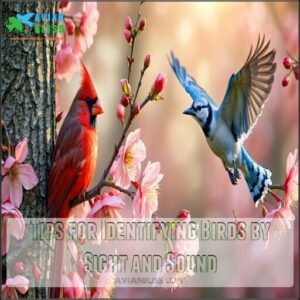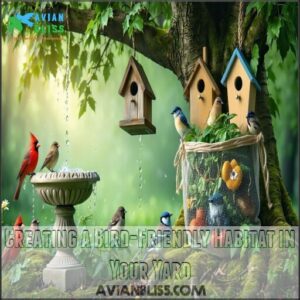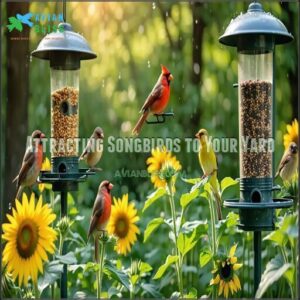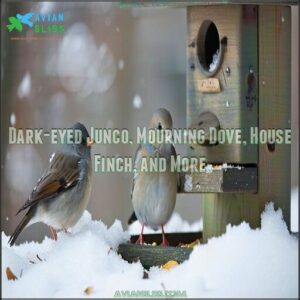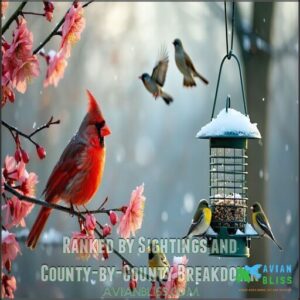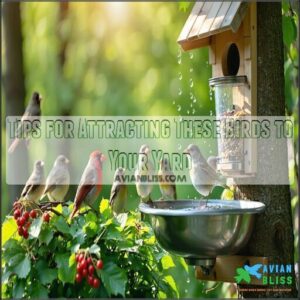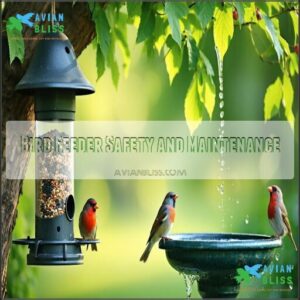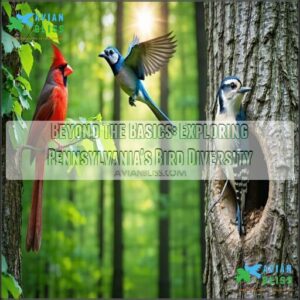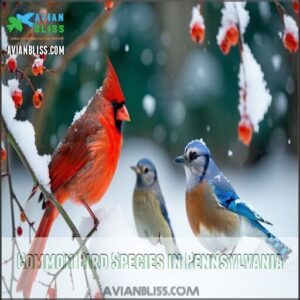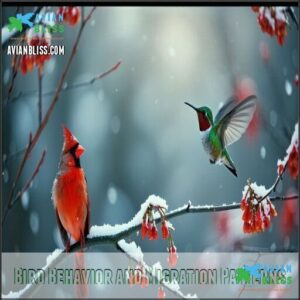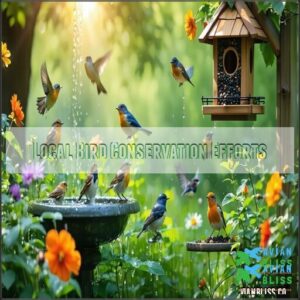This site is supported by our readers. We may earn a commission, at no cost to you, if you purchase through links.
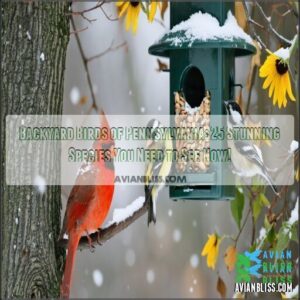 You’ll find 25+ species of backyard birds of Pennsylvania in your yard throughout the year.
You’ll find 25+ species of backyard birds of Pennsylvania in your yard throughout the year.
Cardinals flash bright red against winter snow, while chickadees call their name as they flit between feeders.
Black-capped chickadees, northern cardinals, and American goldfinches are common year-round residents.
Tufted titmice and downy woodpeckers visit suet feeders regularly.
You’ll spot dark-eyed juncos primarily in winter months.
To attract these feathered neighbors, offer black oil sunflower seeds, suet, and fresh water.
Native plants like coneflowers and serviceberry provide natural food sources.
The right habitat elements transform your yard into prime bird real estate.
Table Of Contents
- Key Takeaways
- Pennsylvania’s Most Common Birds
- Identifying Birds in Your Backyard
- Attracting Songbirds to Your Yard
- Pennsylvania’s Top 10 Backyard Birds
- Bird Feeder Safety and Maintenance
- Beyond The Basics: Exploring Pennsylvania’s Bird Diversity
- Common Bird Species in Pennsylvania
- Bird Behavior and Migration Patterns
- Local Bird Conservation Efforts
- Frequently Asked Questions (FAQs)
- What are some common bird species found in Pennsylvania?
- Where is the best place to go birdwatching in Pennsylvania?
- What time of year is the best for birdwatching in Pennsylvania?
- What should I bring on a birdwatching trip in Pennsylvania?
- Can I feed the birds in Pennsylvania?
- What are the most common backyard birds in Pennsylvania?
- What do acrobatic birds look like in Pennsylvania?
- Are mockingbirds common in Pennsylvania?
- What does a Bluebird look like in Pennsylvania?
- How do I identify a bird in my backyard?
- Conclusion
Key Takeaways
- You’ll attract over 25 species of Pennsylvania backyard birds by offering black oil sunflower seeds, suet feeders, and fresh water sources that birds need year-round for drinking and bathing.
- Your top visitors will include Northern Cardinals (appearing in 50% of bird sightings), Black-capped Chickadees, American Goldfinches, and Dark-eyed Juncos (primarily in winter months).
- You’ll create a bird-friendly habitat by planting native trees, shrubs and flowers that provide natural food sources, while keeping feeders clean with a 10% bleach solution to prevent disease spread.
- You can contribute to conservation efforts by participating in citizen science projects like eBird Pennsylvania and the Great Backyard Bird Count, turning your birdwatching hobby into valuable data for researchers.
Pennsylvania’s Most Common Birds
Across Pennsylvania’s backyards, you’ll spot an impressive variety of feathered visitors year-round.
Northern Cardinals top the list, appearing in 50% of all bird sightings with their striking red plumage.
American Robins dominate summer landscapes, while Dark-eyed Juncos prefer winter’s chill.
Blue Jays stand out with their varied diet of nuts and insects, while Mourning Doves quietly become more popular each year.
From Lake Erie to central farmlands, Pennsylvania bird species adapt to diverse habitats.
Watch for Crow behavior—they’re intelligent and social.
Once-abundant Common Grackles now face declining numbers, highlighting why your backyard observations matter for conservation efforts.
This emphasizes the importance of monitoring species like the Northern Cardinals and American Robins to understand population trends and support local biodiversity.
Identifying Birds in Your Backyard
You’ll discover the joy of bird identification by noting key features like size, shape, color patterns, and behaviors of Pennsylvania’s 448 recorded species.
Learning to recognize common backyard visitors such as the bright red Northern Cardinal or blue-crested Blue Jay will transform your ordinary yard into a personal wildlife sanctuary.
Tips for Identifying Birds by Sight and Sound
You can tune into the secret world of Pennsylvania birds right in your backyard by learning key identification skills.
Recognizing birds becomes a breeze when you know what to look for.
Focus on these essential elements:
- Visual Identification: Note plumage patterns, color markings, and distinctive features on wings, head, and belly
- Auditory Cues: Learn to distinguish bird songs and calls – each species has its unique voice
- Behavioral Clues: Watch how birds fly, feed, and interact with surroundings
- Size Comparison: Compare to familiar birds like robins or sparrows
Carry binoculars and a field guide when exploring.
Pennsylvania backyard birds change with seasons, with some species appearing only during specific months.
Bird identification in PA often requires patience and practice.
Start with common backyard birds and gradually expand your knowledge.
Remember that lighting conditions can affect how plumage patterns appear.
Creating a Bird-Friendly Habitat in Your Yard
Ready to welcome birds into your yard? Creating a bird-friendly habitat starts with native plants like oak trees, black-eyed Susans, and serviceberry shrubs that Pennsylvania birds naturally recognize as food sources.
Add water features—even a simple birdbath will attract common backyard birds year-round. Shelter options like evergreen shrubs and birdhouses protect visitors from predators and harsh weather.
Provide nesting sites by leaving dead tree limbs where safe or installing nest boxes. Keep cats indoors and minimize pesticide use to create a safer environment. To truly thrive, consider four-season garden design to guarantee year-round resources.
For attracting birds in PA, try hanging mesh bags with nesting materials like pet fur, yarn scraps, and twigs nearby feeding areas.
Attracting Songbirds to Your Yard
You’ll transform your yard into a songbird paradise with the right combination of diverse seeds, multiple feeder types and fresh water sources.
Native plants like blackberries and sunflowers provide natural food and shelter while attracting Pennsylvania favorites such as cardinals, chickadees and finches to your outdoor space, creating a paradise.
Providing a Variety of Birdseed Blends
During each season, Pennsylvania backyard birds show distinct seed preferences that smart bird feeding strategies can address. Choose your birdseed blends based on which birds visit your yard.
- Black oil sunflower seeds delight Northern Cardinals and chickadees with easy-to-crack shells
- Nyjer seeds attract American Goldfinches that bring bright yellow flashes to your yard
- Safflower seeds draw cardinals while naturally deterring pesky squirrels
- White millet works best for ground-feeding juncos and sparrows
Use protein-rich blends in spring and sunflower-heavy mixes in winter. Find sunflower seed products to enhance your bird feeding. Store seeds in airtight containers to prevent moisture damage. Budget blends work fine for attracting birds PA, using black oil sunflower seeds and considering the best seed preferences.
Offering Different Types of Feeders
The type of feeder you choose matters just as much as the seed inside it. Different Pennsylvania birds prefer specific feeder styles—tube feeders attract finches and chickadees, while platform feeders bring larger birds like blue jays.
Place feeders near protective shrubs but away from predator hiding spots. Install squirrel deterrents to protect your seed variety.
Consider specialty options: nyjer feeders for goldfinches and suet cages for woodpeckers. Choose durable feeder materials like metal or recycled plastic.
For finches and chickadees, consider specialized feeder designs. Clean feeders weekly to prevent disease among common backyard birds.
With the right setup, you’ll enjoy PA’s stunning bird diversity.
Ensuring a Constant Supply of Fresh Water
Beyond feeders, water is the ultimate bird magnet in your Pennsylvania backyard. Birds need fresh water daily for drinking and bathing, regardless of season.
Set up your water sources strategically with these four key approaches:
- Install shallow birdbaths (1-2 inches deep) with rough bottoms so birds can grip safely
- Add a small dripper or water wiggler to create movement that birds find irresistible
- Position water features where birds can see approaching predators but still feel protected
- Use heated birdbaths during Pennsylvania winters when natural water sources freeze solid
Clean all water sources weekly with mild soap to prevent algae buildup. Consider purchasing a bird bath to provide a dedicated water source. Many bird species that ignore your feeders will visit for water, including robins, catbirds, and warblers.
For best results, place birdbaths in partial shade to keep water cooler and reduce evaporation. Your common backyard birds will thank you with increased visits and delightful bathing displays, making your backyard a bird-friendly haven with fresh water.
Creating a Bird-Friendly Habitat
Transforming your yard into a bird-friendly habitat takes just a few thoughtful changes. Pennsylvania’s native birds thrive when you provide their four basic needs.
- Native plants offer natural food sources through seeds, berries, and by hosting insects that birds eat
- Water features like shallow bird baths give birds places to drink and bathe, even in winter months
- Shelter options including dense shrubs, trees, and brush piles protect birds from weather and predators
Place nesting sites such as birdhouses 5-30 feet high, away from where predators can reach them. Common backyard birds need safe yards where cats stay indoors and feeders sit away from hiding spots.
Your backyard can become a certified bird habitat while you enjoy the sights and sounds of native Pennsylvania birds. The right bird attractants create a natural environment that welcomes diverse species all year long.
Pennsylvania’s Top 10 Backyard Birds
You’ll spot Northern Cardinals, Blue Jays, American Robins and other colorful visitors in Pennsylvania yards throughout the year.
These top 10 species make up over half of all backyard bird sightings in the state with Cardinals appearing on 50% of birdwatching lists.
Dark-eyed Junco, Mourning Dove, House Finch, and More
Pennsylvania’s winter bird trio – Dark-eyed Juncos, Mourning Doves, and House Finches – bring distinctive charm to your backyard bird sanctuary.
| Bird | Key Feature | Winter Habit | Diet | Attraction Tip |
|---|---|---|---|---|
| Dark-eyed Junco | Gray hood, white belly | Ground foraging | Seeds, insects | Scatter millet |
| Mourning Dove | Tan with black spots | Forms small flocks | Seeds, grains | Platform feeders |
| House Finch | Red head (males) | Visits feeders often | Sunflower seeds | Tube feeders |
| American Goldfinch | Winter olive color | Travels in groups | Nyjer seeds | Mesh feeders |
| Tufted Titmouse | Gray with crest | Bold feeder visitor | Sunflower seeds | Suet blocks |
You’ll spot Juncos hopping like tiny snowbirds across your lawn, while Doves prefer ground feeding. House Finches add splashes of red against winter’s gray backdrop, with males showing vibrant coloration. Many of these birds are frequent feeder visitors. Listen for their cheerful songs even on cold days – nature’s reminder that spring will return.
Ranked by Sightings and County-by-County Breakdown
Data from county hotspots shows distinct regional variations in PA bird species sighting frequency.
You’ll find:
- Northern Cardinals lead in Washington County as the most reported backyard visitor
- Dark-eyed Juncos dominate both Crawford and Wayne Counties year-round
- European Starlings top the charts in Columbia County with consistent numbers
- American Goldfinches appear frequently in Crawford and Washington Counties
- Red-tailed Hawks rule Tussey Mountain in Centre County with 626 recorded sightings
These abundance factors help with data interpretation when bird watching Pennsylvania. Each county develops unique patterns in Pennsylvania birding populations.
You can use these Pennsylvania birdwatching spots trends to predict which species you’ll likely encounter in your area, considering the regional variations and species sighting frequency to make the most of your bird watching experience, and understanding the importance of Pennsylvania birding populations and backyard visitor patterns.
Tips for Attracting These Birds to Your Yard
Cardinals, chickadees, and finches will flock to your yard with these simple strategies.
Position bird feeders Pennsylvania near shrubs or trees for quick escape from hawks.
Add water features like shallow bird baths that attract small birds Pennsylvania even when they’re not hungry.
Native plants provide natural food sources and shelter options year-round.
Different seed types attract various PA bird species – try black oil sunflower for cardinals and nyjer for finches.
Install birdhouses at species-appropriate heights for nesting.
Remove potential predator hiding spots and keep cats indoors.
With consistent feeding backyard birds, you’ll create bird habitats they can’t resist.
Bird Feeder Safety and Maintenance
You’ll keep your feathered friends healthy and happy with proper feeder maintenance that prevents disease spread among Pennsylvania’s backyard birds.
Clean your feeders regularly with a 10% bleach solution and provide fresh water sources to guarantee birds can safely enjoy the food you provide.
Protecting Birds From Disease
While our top 10 backyard birds bring joy to Pennsylvania yards, keeping them healthy requires attention to disease prevention.
Birds can spread illnesses quickly when they gather at feeders. Protect your feathered visitors with these simple practices:
- Limit exposure between wild and captive birds
- Wash hands before and after handling feeders
- Isolate new birds for 30 days to monitor for illness
- Keep wildlife and rodents away from feeding areas
- Provide multiple feeding stations to reduce crowding.
Good feeder hygiene creates habitat health for Pennsylvania’s birds. When feeders become contamination zones, bird immunity suffers. Taking these steps supports bird conservation in PA while ensuring your backyard remains a safe haven for local species.
Regularly Cleaning Feeders With a 10% Bleach Solution
While protecting your birds is key, keeping their dining spots clean deserves equal attention. A proper bleach solution creates a safe environment for Pennsylvania’s backyard visitors.
Creating your bird-friendly disinfectant is simple:
- Mix 1 part bleach with 9 parts water in a clean bucket
- Disassemble your feeders completely before soaking
- Submerge all parts for 10-15 minutes
- Scrub with a dedicated brush (not your kitchen scrubber!)
- Rinse until no bleach smell remains – birds have sensitive respiratory systems
Your feeder cleaning frequency depends on weather and traffic. Clean every two weeks during warm months and monthly in winter. After heavy rain, check for moldy seed and clean immediately.
Bird health impacts extend beyond your yard – proper cleaning prevents disease spread throughout your local bird population. For those concerned about bleach, vinegar works as an alternative disinfectant, though it requires longer soaking time.
Avoiding Overcrowding at Feeders
Many Pennsylvania bird enthusiasts face a common challenge: feeders that become too crowded.
To prevent disease spread, place your feeders at least 6-8 feet apart across your yard.
Offering different food types naturally distributes your feathered visitors.
| Feeder Type | Ideal Spacing | Benefits |
|---|---|---|
| Tube Feeders | 8-10 feet apart | Reduces competition |
| Platform Feeders | 10-12 feet apart | Prevents overcrowding |
| Suet Feeders | 6-8 feet apart | Distributes woodpeckers |
This space management approach reduces stress among birds while creating better birdwatching opportunities for you, and it helps to prevent disease spread by ensuring proper feeder spacing.
Providing Fresh Water Sources
Fresh water sources act as powerful magnets for Pennsylvania bird species, including those that ignore bird feeders.
Birds need water for drinking and bathing throughout all seasons.
- Place birdbaths 10-15 feet from dense shrubs so birds can quickly escape from predators
- Clean water sources weekly using a 9:1 water-to-vinegar solution to prevent algae growth
- Install heated bird baths in winter when natural water sources freeze over
- Add water wigglers or small fountains to prevent mosquitoes and attract birds with movement
Your water source placement matters.
Position it where you can watch birds splash and bathe from a window.
Pennsylvania bird habitats benefit from year-round water access.
Many birders report that adding fresh water sources doubles the number of bird species visiting their yards compared to using bird feeders alone, which is a significant benefit.
Beyond The Basics: Exploring Pennsylvania’s Bird Diversity
Pennsylvania’s 439 bird species offer you wildlife experiences beyond your basic backyard feeders.
You’ll discover new species and contribute to conservation by joining citizen science projects that track bird populations across the state’s diverse habitats, which supports conservation efforts.
Participating in Citizen Science Projects
Turn your backyard bird watching into valuable scientific contribution by joining citizen science projects across Pennsylvania.
These programs transform your observations into vital data collection that helps researchers track and protect our 448 native bird species.
Get involved with these simple projects:
- eBird Pennsylvania: Record your daily sightings through this Cornell Lab platform to help track migration patterns and population changes.
- Great Backyard Bird Count: Spend just 15 minutes counting birds during this February event to contribute to nationwide research.
- Project FeederWatch: Document your winter visitors from November through April to help scientists monitor bird populations.
Your participation builds essential community engagement while developing your birdwatching skills.
Even beginners can make meaningful contributions – every sighting matters! Pennsylvania birdwatching events welcome all skill levels, so don’t worry about making mistakes.
Supporting Local Bird Conservation Organizations
After learning about citizen science, you can help Pennsylvania’s birds by supporting local conservation groups. These organizations protect the birds that visit your backyard and beyond.
You can make a difference through:
- Bird Town Pennsylvania works with local communities to create bird-friendly habitats and restore native plant communities
- Audubon Pennsylvania protects Important Bird Areas and threatened habitats throughout the state
- Allegheny Bird Conservation Alliance focuses on bird conservation in Western Pennsylvania through education and outreach
- Willistown Conservation Trust conducts avian research and promotes bird-friendly practices
Your support provides funding for habitat preservation projects that birds need to thrive. Join volunteer opportunities at wildlife refuges, attend educational programs about responsible birdwatching, or advocate for policies that protect bird habitats. Every action helps guarantee Pennsylvania remains a bird paradise.
Common Bird Species in Pennsylvania
You’ll spot at least 439 bird species across Pennsylvania, with Northern Cardinals, Blue Jays, and American Robins frequently visiting backyard feeders.
These common visitors display distinctive features like the Cardinal’s bright red plumage and the Robin’s orange-brown breast that make identification simple even for beginners, showcasing distinctive features and bright red plumage.
Cardinal, Chickadee, Purple Grackle, and More
While exploring Pennsylvania’s bird diversity gives you a broad overview, you’ll want to know the common stars of your backyard show.
Your Pennsylvania yard hosts a wonderful cast of feathered residents. The Northern Cardinal tops the popularity chart, appearing in 50% of bird counts with its striking red plumage and cheerful songs. Two Chickadee species—Black-capped and Carolina—dart around with their distinctive black caps, while Common Grackles showcase iridescent purple-blue feathers that catch the sunlight.
| Species | Diet | Seasonal Presence |
|---|---|---|
| Northern Cardinal | Seeds, fruits, insects | Year-round |
| Black-capped Chickadee | Seeds, insects, berries | Year-round |
| Carolina Chickadee | Seeds, insects | Year-round |
| Common Grackle | Insects, seeds, small fish | Spring-Fall |
Cardinal behavior includes year-round singing, while Chickadee diet varies seasonally. Open fields and meadows support these birds and native wildflowers, essential for pollinators and biodiversity. Regional variations exist across PA, with Lake Erie areas hosting unique species not seen in central regions. These colorful birds PA transform ordinary spaces into lively nature havens.
Identifying Birds by Sight and Sound
With careful observation, you can identify Pennsylvania’s birds through several key characteristics. Becoming familiar with these traits helps you recognize your feathered visitors quickly.
- Visual cues: Watch for distinctive markings like the Cardinal’s crest or the Chickadee’s black cap. Size comparison to common birds like robins can help with bird identification PA.
- Bird songs: Learn to distinguish calls vs. songs – Cardinals whistle "cheer-cheer" while Chickadees announce their name with "chicka-dee-dee-dee." Regional dialects may vary slightly.
- Behavior patterns: Notice how Nuthatches climb headfirst down tree trunks while Woodpeckers move upward.
- Habitat preferences: Spot Juncos on the ground in winter and Goldfinches on thistle plants in summer.
- Flight style: Observe how Woodpeckers fly in undulating patterns while finches bounce through the air.
Free smartphone apps now offer both visual and auditory identification tools for bird sounds.
Bird Behavior and Migration Patterns
You’ll notice Pennsylvania’s backyard birds follow distinct patterns as they feed, mate and migrate through our changing seasons.
Some species like cardinals stay year-round while others such as the ruby-throated hummingbird travel thousands of miles between their summer homes here and winter habitats farther south.
Understanding Bird Migration Patterns
While Pennsylvania hosts many year-round residents, the rhythmic coming and going of migratory birds adds excitement to your backyard birding.
Pennsylvania sits at a critical junction of the Atlantic Flyway, where birds travel ancient pathways across continents. You’ll notice these seasonal changes throughout the year as migration triggers prompt birds to move.
Here’s what shapes bird migration patterns in Pennsylvania:
- Temperature shifts signal birds when to start their journeys, with most spring arrivals occurring mid-April to mid-May
- Flyway routes follow geographic features like mountain ridges and river valleys, especially the Western Appalachians
- Climate effects have shifted traditional timing, with some species arriving up to two weeks earlier than decades ago
- Conservation impacts are greatest where stopover habitats remain protected
Many birds navigate using stars, landmarks, and Earth’s magnetic field. Watch for these seasonal travelers at local wildlife refuges or in your own backyard during peak migration periods.
Identifying Birds by Behavior
To identify birds by behavior, look for five key movement patterns.
Watch how different species move, eat, and interact with others.
Cardinals walk slowly on the ground while chickadees move quickly between branches.
| Behavior | What It Shows | Examples | When to Watch |
|---|---|---|---|
| Foraging Habits | Feeding style | Woodpeckers drilling, finches cracking seeds | Morning |
| Vocalizations | Territory claims | Cardinal’s "cheer-cheer," Jay’s harsh call | Dawn |
| Flight Patterns | Bird family | Woodpecker’s undulating flight | Daytime |
| Social Interactions | Group dynamics | Goldfinches in flocks, solo robins | Evening |
Combine these behavior clues with visual traits for easier songbird identification in Pennsylvania, using key movement patterns to enhance your understanding.
Tips for Observing Birds in Your Yard
From your backyard window, you can witness Pennsylvania’s avian wonders with these simple observation strategies:
- Set up bird feeders where they’re visible from comfortable indoor viewing spots – place them 10-12 feet from windows to prevent collisions
- Schedule your birdwatching during peak activity times – early morning (6-9 AM) and late afternoon (4-6 PM)
- Keep quality binoculars and field guides within easy reach for quick identification
- Maintain a small notebook for recording species, behaviors, and patterns
Stay quiet and still during observation sessions. Ethical birding means respecting their space while you enjoy their natural behaviors. It’s about creating an environment where you can witness Pennsylvania’s avian wonders and learn from their natural behaviors.
Planting Native Trees, Shrubs, and Flowers
Now that you’ve set up your observation spot, add native plants to make your yard a bird paradise. Pennsylvania’s local birds thrive with plants they evolved alongside.
- Eastern Redbud trees produce nectar-rich flowers that attract hummingbirds in spring
- Serviceberry shrubs offer summer berries that cardinals and robins devour
- Oak trees support over 500 caterpillar species that feed chickadees and titmice
- Elderberry provides both fruit and nesting sites for many songbirds
- Purple coneflower seeds become winter food for goldfinches when left standing
Native plants need less water and care than exotic varieties while creating natural habitat connections. Your yard becomes part of the larger ecosystem, supporting bird diversity throughout all seasons, which is essential for creating a bird paradise with local birds.
Avoiding Pesticides and Herbicides
While native plants provide shelter, pesticides harm the birds that call your yard home.
Chemical treatments destroy the natural food web that Pennsylvania songbirds depend on:
- Pesticides kill insects that parent birds need to feed hungry nestlings
- Herbicides eliminate seed-producing plants that sustain songbirds year-round
- Chemicals contaminate soil and water sources where birds drink and bathe
Try safe alternatives like organic gardening methods or encouraging natural predators instead. Your bird feeders will attract more visitors when your yard’s habitat health improves.
Providing a Source of Fresh Water
Fresh water’s appeal to Pennsylvania’s birds can’t be overstated.
Birds require water year-round for drinking and bathing, making it essential to your birdwatching experience.
Place bird baths in semi-shaded spots, away from bushes where predators might hide.
Clean waterers weekly with mild soap to prevent mosquitoes and disease.
Creating a Bird-Friendly Yard
Beyond providing water, creating an ideal bird habitat transforms your Pennsylvania yard into a thriving ecosystem.
Water features naturally complement a well-designed bird sanctuary.
Turn your outdoor space into a bird haven with these simple improvements:
- Plant native Pennsylvania trees and shrubs that produce berries, nuts, and seeds
- Create shelter options at various heights using dense shrubs and brush piles
- Install different types of bird feeders with black oil sunflower seeds and nyjer
- Place nesting boxes away from busy areas and walking paths
- Add baffles to bird feeder poles to prevent squirrels and predators
Native plants attract insects that birds need for feeding their young.
Your thoughtful yard design offers birds everything they need – food, water, shelter, and safety.
Pennsylvania bird conservation starts in backyards like yours, where birdwatching becomes a daily joy as different bird species discover your welcoming habitat.
Local Bird Conservation Efforts
While enjoying Pennsylvania’s birds, you can actively support their survival through local conservation efforts.
Join the Audubon Society or local birdwatching conservation groups to protect our feathered friends. Pennsylvania bird conservation depends on volunteers like you tracking populations and restoring habitats.
Citizen science initiatives are essential for monitoring bird populations. Your backyard can become a sanctuary when you avoid pesticides and plant native species.
Funding sources for bird conservation PA come from donations and grants.
Frequently Asked Questions (FAQs)
What are some common bird species found in Pennsylvania?
Like feathered jewels in your backyard, Pennsylvania hosts Northern Cardinals, Blue Jays, American Robins, Mourning Doves, and Chickadees year-round. You’ll also find Goldfinches, Woodpeckers, Titmice, and seasonal visitors like Hummingbirds.
Where is the best place to go birdwatching in Pennsylvania?
You’ll find excellent birdwatching at Hawk Mountain Sanctuary and Bald Eagle State Park.
John Heinz National Wildlife Refuge offers diverse wetland species too.
Pack binoculars and visit during spring migration for best results.
What time of year is the best for birdwatching in Pennsylvania?
Spring migration (April-May) offers you the most bird activity, but each season has unique sightings. Summer showcases breeding birds, fall brings migrants heading south, and winter features unique northern species.
What should I bring on a birdwatching trip in Pennsylvania?
You’ll need binoculars, a field guide or bird ID app, comfortable weather-appropriate clothing, water, snacks, a notebook, and a camera. Don’t forget sunscreen and bug spray during warmer months.
Can I feed the birds in Pennsylvania?
Yes, you can absolutely feed wild birds in Pennsylvania. It’s legal and encouraged. Many residents attract cardinals, chickadees, and woodpeckers with seed feeders, suet, and native plants year-round.
What are the most common backyard birds in Pennsylvania?
While cardinals flash red brilliance, blue jays announce their presence loudly.
You’ll spot northern cardinals, blue jays, mourning doves, American robins, and song sparrows most frequently in your Pennsylvania yard throughout the seasons, with blue jays and northern cardinals being among the most common visitors.
What do acrobatic birds look like in Pennsylvania?
You’ll spot Pennsylvania’s acrobatic birds by their nimble movements.
Chickadees hang upside-down from branches, nuthatches walk headfirst down tree trunks, and goldfinches perform undulating flight patterns with their distinctive bouncy style, showcasing their unique abilities as acrobatic birds.
Are mockingbirds common in Pennsylvania?
Birds of a feather flock together, but not mockingbirds in Pennsylvania.
You’ll find them in modest numbers across the state.
They aren’t as common as cardinals or robins in your backyard.
What does a Bluebird look like in Pennsylvania?
Eastern Bluebirds in Pennsylvania have bright blue wings and tails with rusty-orange throats and breasts. Males display more vibrant blue colors, while females show duller, grayish-blue plumage with orange-brown underparts.
How do I identify a bird in my backyard?
Look for size (compare to familiar birds), distinctive colors, patterns, shape of bill, and behavior.
Note habitat and sounds.
Use a field guide or birding app to match your observations for accurate identification.
Conclusion
Pennsylvania’s backyards host an impressive 25+ bird species year-round, with over 80% of these birds responding positively to native plantings.
Your yard can become a vibrant sanctuary for backyard birds of Pennsylvania with just a few simple steps.
Add a variety of feeders, maintain fresh water sources, and incorporate native plants like coneflowers.
You’ll soon enjoy the cheerful songs of chickadees, the flash of cardinal red, and many more colorful visitors in every season.


